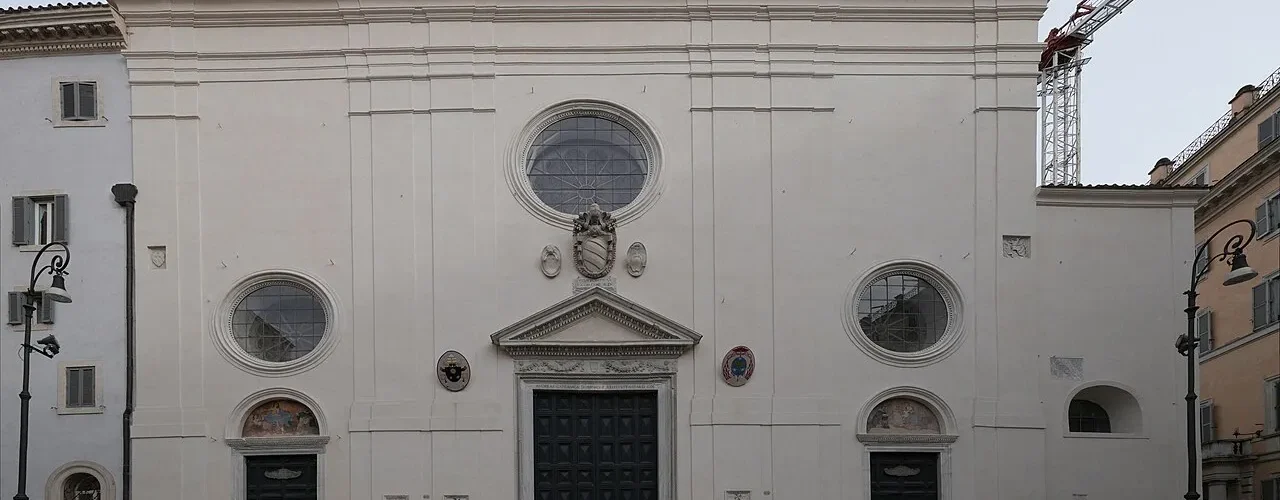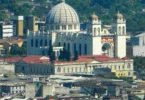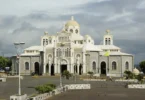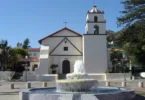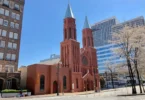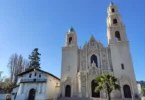Introduction

The Basilica of Santa Maria sopra Minerva (Latin: Basilica Sanctae Mariae supra Minervam) is a prominent minor basilica located in the Pigna district of Rome, Italy, situated in Piazza della Minerva, close to the famous Pantheon. Known for its distinct Gothic architectural style, Santa Maria sopra Minerva stands out as one of the very few examples of Gothic architecture in the city, a style otherwise rare in Rome. The basilica is historically significant not only for its architectural beauty but also for being the final resting place of several important figures. These include Saint Catherine of Siena, who was proclaimed a Doctor of the Church in 1970; the renowned mystic painter Beato Angelico, who was declared the “Universal Patron of Artists” in 1984; and Pope Benedict XIII. Additionally, the church houses invaluable works of art, including frescoes by Melozzo da Forlì and Filippino Lippi, among others.
A historically notable event associated with the basilica is that in 1633, Galileo Galilei, the father of modern astronomy, abjured his scientific theories in order to avoid condemnation by the Holy Inquisition. This took place in the convent adjacent to the church. Santa Maria sopra Minerva is also significant for its connection to the Order of Preachers (Dominicans), as it is one of their major churches in Rome. The church’s name derives from the fact that it was built directly over the remains of a temple dedicated to the Egyptian goddess Isis, which was mistakenly attributed to the Greco-Roman goddess Minerva.
The basilica’s location in Piazza della Minerva places it within the ancient district of the Campus Martius, just a block east of the Pantheon. Despite the many Baroque renovations that have altered other medieval churches in Rome, Santa Maria sopra Minerva remains a prime example of original Gothic architecture. The church features a restrained Renaissance-style façade, while its interior showcases classic Gothic elements, including arched vaulting painted in blue with gilded stars, later restored with red ribbing during the 19th century Neo-Gothic restoration. Throughout its history, the basilica and its adjoining convent served as the headquarters for the Dominican Order at various points, though this role has since shifted to the Santa Sabina convent. The titulus of the basilica was conferred upon Cardinal António Marto on 28 June 2018.
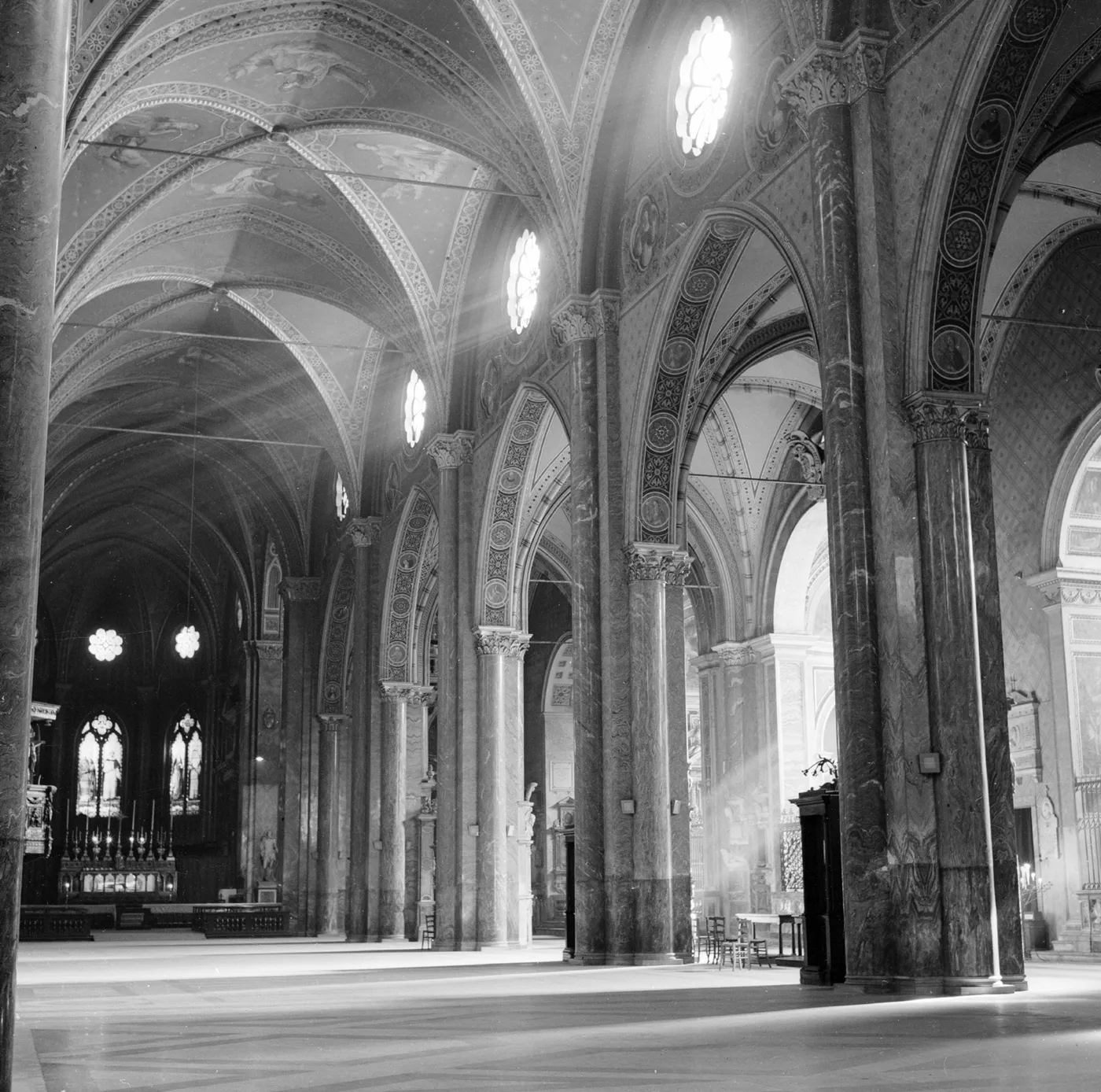
The history of the Basilica of Santa Maria sopra Minerva traces its origins back to ancient Roman times. The area where the basilica now stands was once home to several religious buildings, including the Minervium, a temple dedicated to the goddess Minerva built by Gnaeus Pompey around 50 BC. Other structures in the vicinity included the Iseum, dedicated to Isis, and the Serapeum, dedicated to Serapis. The name “Minervium” came from the temple of Minerva Chalcidica, constructed by Emperor Domitian in the Campus Martius. Initially, it was believed that the church was built directly atop this temple, but further investigations suggested it was more likely constructed in alignment with the present Church of Santa Marta in Piazza del Collegio Romano.
The church’s origins as a Christian site date back to the 8th century, when it was an oratory dedicated to the Virgin Mary, with the toponym Minervum referencing the ancient pagan temple. This oratory was assigned to Basilian nuns from Constantinople around 741–752, when Pope Zachary Christianized the area. The structure eventually disappeared, but in 1255, Pope Alexander IV established a community of converted women on the site. Later, the Dominican Order took possession in 1266, and by 1275, they had complete control over the church, establishing a Dominican convent and school, known as insula sapientiae or the “Island of Wisdom.”
Construction of the Gothic Church
In 1280, the construction of the current Gothic church began under the Dominican friars, who took inspiration from the Dominican Santa Maria Novella church in Florence. Funding for the project came from Pope Boniface VIII and many devoted supporters. Construction of the church continued throughout the centuries, with significant progress made in the 14th century when the side aisles were completed. In 1453, the main nave was vaulted, and Count Francesco Orsini funded the construction of the church’s façade, though it remained unfinished in exposed brick until 1725, when Pope Benedict XIII completed the work.
Baroque and Neo-Gothic Transformations
In the early 1600s, the church underwent significant Baroque modifications, including the transformation of the pointed Gothic arches of the naves into round arches, giving the interior a more Baroque appearance. The church became a titular church in 1557, with the first titular cardinal being Michele Ghislieri, who later became Pope Pius V. In 1566, Pope Pius V raised the church to the status of a minor basilica.
Between 1848 and 1855, Girolamo Bianchedi led restoration efforts that removed many of the Baroque additions and restored the church’s Gothic structure. During this time, Neo-Gothic frescoes were added to the bare walls. In the early 20th century, the church’s stained glass windows were primarily installed, and in 1909, a great pneumatic organ was built by Carlo Vegezzi Bossi, which was later restored in 1999.
The Basilica of Santa Maria sopra Minerva played a significant role in papal history, hosting two papal conclaves. In 1431, the basilica served as the location for the conclave that elected Pope Eugenius IV. Another conclave was held here in 1447, which resulted in the election of Pope Nicholas V.
Dominican College and Inquisition
In the 16th century, the studium conventuale at Santa Maria sopra Minerva became a hub for theological studies, particularly under the leadership of Juan Solano, a Dominican bishop from Peru. In 1577, he restructured the study program and created the College of St. Thomas in honor of Thomas Aquinas, who was canonized in 1323. This college played a central role in the education of Dominican friars and became integral to the religious life at the basilica.
In 1628, by papal decree, the Minerva Convent was designated as the seat of the Congregation of the Holy Office, where the Roman Inquisition held its meetings. It was here that Galileo Galilei abjured his Copernican theory of heliocentrism on 22 June 1633 after being tried for heresy.
Decline, Restoration, and Modern Developments
The Dominican Order faced many challenges in the late 18th and early 19th centuries, particularly during the French occupation of Rome. During this period, the College of St. Thomas was briefly closed and eventually relocated to the Pontifical University of Saint Thomas Aquinas (Angelicum) in 1963. In the late 19th century, the basilica underwent significant restorations, and today, it remains a vital religious and historical site, with a profound connection to the Dominican Order and Catholic intellectual life.
Architecture of the Basilica of Saint Mary of Minerva, Rome, Italy
Architect : Carlo Maderno
Architectural Styles : Gothic architecture, Medieval architecture, Italian Gothic architecture
Burials : St Catherine Of Siena, Pope Leo X, Andrea Bregno
Facade
The facade of the Church of Santa Maria sopra Minerva is predominantly Romanesque in style, featuring influences from the Abruzzo region and the Renaissance period. However, it stands in contrast to the Gothic architectural style found within the church. The Renaissance decorations were the work of the architect Raguzzini, dating back to the eighteenth-century intervention by Pope Benedict XIII. Notably, the large main portal is a nineteenth-century addition, complete with a frieze adorned with garlands.
In the square in front of the church, an Egyptian obelisk stands atop a base designed by Ercole Ferrata, following a design by Gian Lorenzo Bernini. The obelisk is uniquely topped with a small elephant sculpture, a charming detail that catches the eye. On the right side of the facade, a series of indicators mark the historical flood levels of the nearby Tiber River. The earliest of these markers dates to 1422, during the pontificate of Martin V, and the most recent flood level was recorded in December 1870.
Interior

Nave
The interior of the church is designed with three naves, each supported by massive pillars, and features a transept and a deep apse. The central vault and the church’s walls are decorated with a complex series of neo-Gothic frescoes, a result of the restoration work carried out in the 19th century by Bernardino Riccardi, Pietro Gagliardi, Tommaso Greggia, and Raffaele Casnédi. The two side naves contain various chapels that preserve their Baroque character, some of which include the following notable examples:
Chapel of the Annunziata: Designed by Carlo Maderno, this chapel contains an Annunciation fresco by Antoniazzo Romano.
Aldobrandini Chapel: Built in the early 17th century by Giacomo della Porta and Stefano Maderno, it houses the funerary monuments of the parents of Pope Clement VIII, Salvestro Aldobrandini and Luisa Dati. The altar is adorned with a painting by Federico Barocci, and the frescoes on the vault are the work of Cherubino Alberti.
Baptistery: Located within the thickness of the facade, the baptistery features a canvas of the Noli Me Tangere by Marcello Venusti, a significant Renaissance piece.
Chapel of San Raimondo di Peñafort: This chapel contains the tomb of Cardinal Giovanni Diego de Coca, designed by Andrea Bregno, along with a fresco depicting Christ the Judge between two angels by Melozzo da Forlì.
Chapel of St. Domenico: Designed by Filippo Raguzzini, this chapel contains the tomb of Pope Benedict XIII, with decorations by Carlo Marchionni and Pietro Bracci. The chapel also features the “Madonna with Child and Saints John the Baptist and John the Evangelist,” a sculpture by Francesco Grassia dating around 1670.
Carafa Chapel: An important early Renaissance work, this chapel is entirely frescoed by Filippino Lippi for Cardinal Oliviero Carafa. The frescoes, which include depictions of the Annunciation and the Assumption, were completed between 1488 and 1493. The chapel also features the funerary monument of Pope Paul IV, designed by Pirro Ligorio in the 1560s.
The church contains other valuable works of art from the 15th and 16th centuries, such as works by Raffaellino del Garbo and a funerary slab of Beato Angelico. Michelangelo’s “Christ Carrying the Cross,” a significant statue, is housed in the church, as well as various funerary monuments and cenotaphs designed by Gian Lorenzo Bernini.
The Main Altar and Tomb of Saint Catherine of Siena
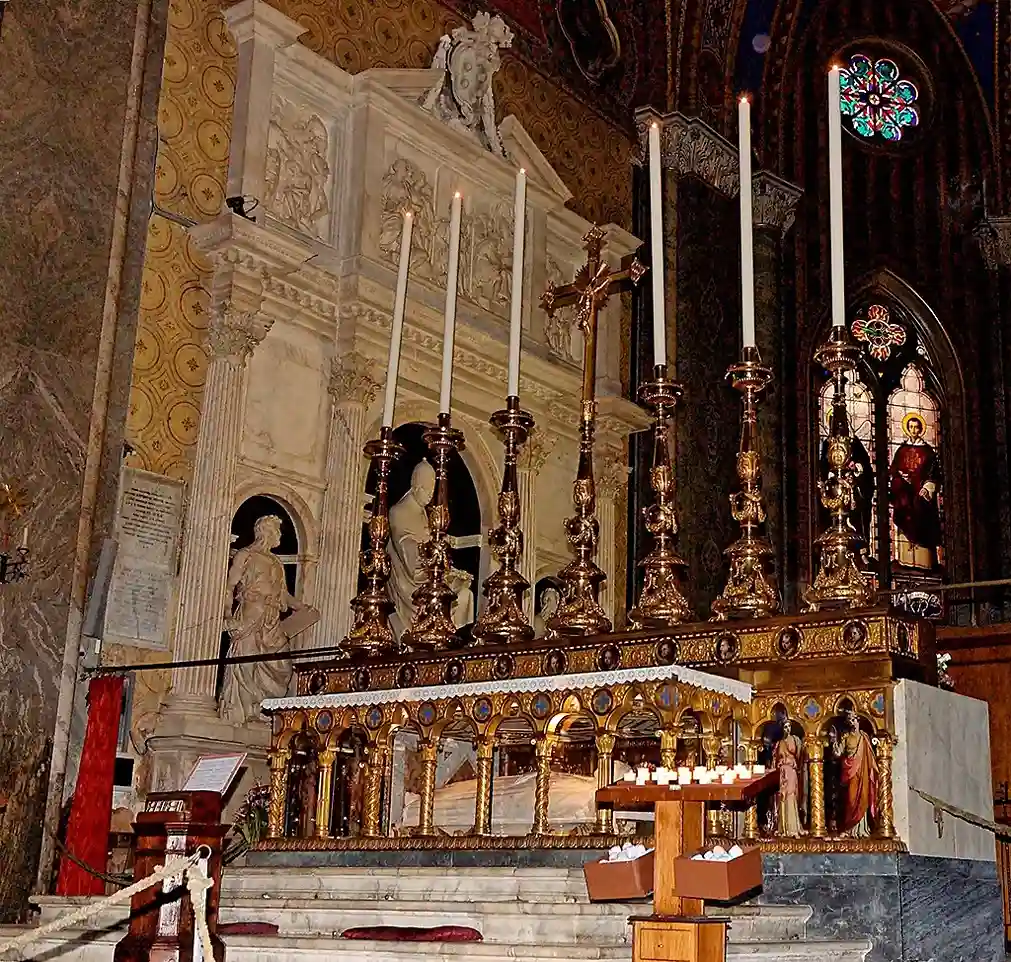
The main altar is designed in a neo-Gothic style, and beneath the altar table lies the tomb of Saint Catherine of Siena. Her remains are encased in a 15th-century sarcophagus, which was restored in the late 1990s. Notably, Saint Catherine’s skull and a finger are kept in the Basilica of San Domenico in Siena. The sarcophagus features a recumbent statue of the saint on its lid.
In the apse, illuminated by three large mullioned windows, are the tombs and monuments of several prominent popes and cardinals, including Pope Leo X and Pope Clement VII, both Medici popes. These tombs feature statues by Baccio Bandinelli. Among the tombstones on the floor, one marks the resting place of the cardinal and humanist Pietro Bembo, who died in 1547.
Additional funerary monuments in the basilica include those of Pope Paul IV, Urban VII, and Benedict XIII, the latter featuring a statue by Pietro Bracci. The altar canvas in the sacristy was created by Andrea Sacchi in the 1630s on commission from Cardinal Antonio Barberini.
Pipe Organs
The church houses several notable organs, including the Vegezzi Bossi organ. In 1628, organ builder Ennio Bonifazi constructed two nearly identical organs for the church, positioning them in the transepts above the choir stalls. In 1909, the Vegezzi Bossi company built a new pneumatic transmission organ in the body of the left organ, which remains in use today. A third organ was installed in the church in 1965 by the Mascioni company.
Convent
The Church of Santa Maria sopra Minerva is part of one of the most significant Dominican convents in Rome. Established in the 14th century, the convent became the seat of high-ranking Dominican officials, such as the Master General and Procurator. It was the site of two conclaves, during which popes Eugene IV (1431) and Nicholas V (1447) were elected. Additionally, it was here that Galileo Galilei recanted his views under the Inquisition. Architecturally, the convent is divided into two cloisters: the Guidetti cloister, rebuilt at the end of the 16th century, and the Cisterna cloister, which dates from the 15th century and features spolia from Roman columns. In the late 16th century, under the direction of Vincenzo Giustiniani, the convent was enlarged and embellished. The “Galileo Rooms” in the convent were decorated with frescoes that highlight the Dominican order’s role in fighting heresy.
In the early 18th century, the Casanatense Library was established in the convent, which houses a remarkable monumental hall. During the Napoleonic occupation of Rome (1808-1814), the convent was used as a barracks and was later expropriated by the Italian state in 1870. Today, part of the former convent is occupied by a community of Dominican friars, and the remainder of the space houses the Parliamentary Library Center.
Notable Artworks
Among the church’s many treasures, the most famous works include Michelangelo’s “Cristo della Minerva” (Christ the Redeemer), completed in 1521. The Carafa Chapel’s fresco cycle by Filippino Lippi, created between 1488 and 1493, is also highly significant. Other notable funerary monuments in the church include those of Pope Leo X and Pope Clement VII by Baccio Bandinelli, as well as the tomb of Fra Angelico, created by Isaia da Pisa in 1455.
Burials at the Church of Santa Maria sopra Minerva
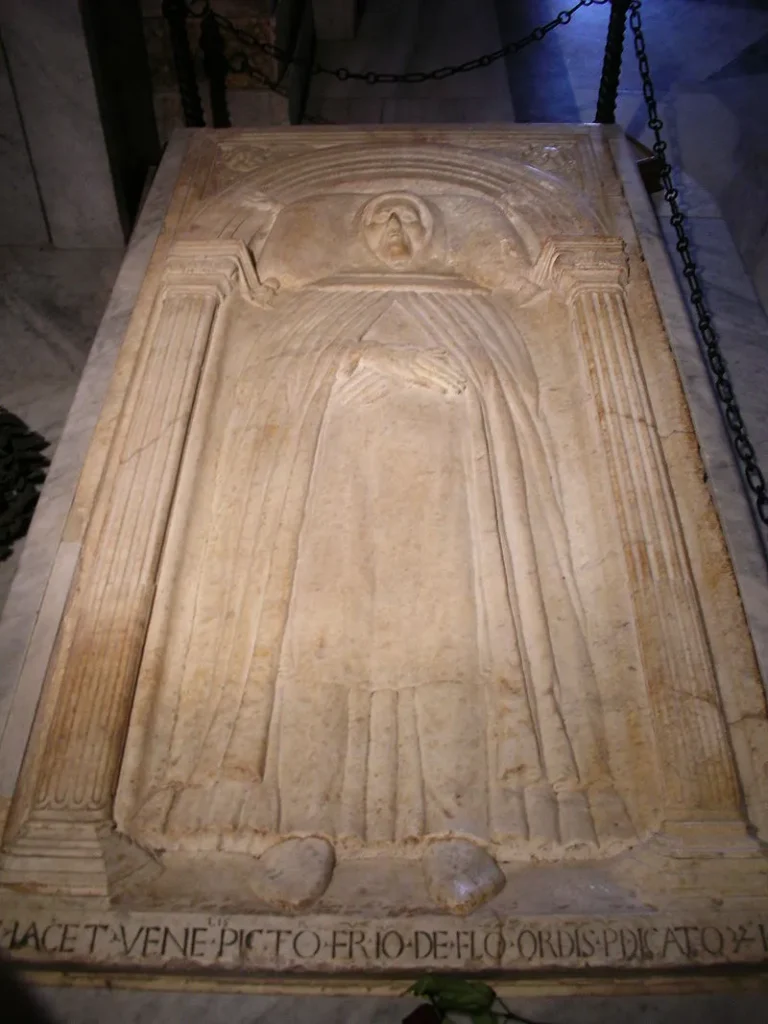
The Church of Santa Maria sopra Minerva is the final resting place for several notable figures, including Saint Catherine of Siena. Although her body is buried here, her head is kept in the Basilica of San Domenico in Siena. A room was reconstructed in 1637 by Antonio Barberini to replicate the space where Saint Catherine died in 1380, making it one of the earliest examples of a “transplanted interior,” a concept that later inspired 19th and 20th-century museum “period rooms.” The frescoes by Antoniazzo Romano that originally adorned this room have since been lost.
Fra Angelico
Fra Angelico, the renowned early Renaissance painter, also passed away in the adjoining Dominican convent and was buried in the church. His fresco cycle in the convent’s cloister, commissioned by Cardinal Juan de Torquemada, has unfortunately not survived.
Florentine Tombs
Prior to the construction of the Church of San Giovanni dei Fiorentini, Santa Maria sopra Minerva served as the church for Florentines in Rome, leading to the burial of numerous prominent Florentine figures. The most notable tombs include those of the Medici Popes, Leo X and Clement VII, whose tombs were designed by Florentine sculptor Baccio Bandinelli. The church also houses the tomb of Diotisalvi Neroni, a refugee involved in a plot against Piero de’ Medici.
Additional Notable Burials
In addition to the Medici Popes and Diotisalvi Neroni, the church is the final resting place of several other significant figures. These include Pope Urban VII, Pope Paul IV, Cardinal Latino Malabranca Orsini (the cardinal-nephew of Pope Nicholas III), Michel Mazarin (the Archbishop of Aix and brother of Cardinal Jules Mazarin), Byzantine philosopher George of Trebizond, Renaissance architect Filarete, and surgeon Mariano Santo. Cardinal Astorgio Agnensi also has a tomb monument in the convent’s cloister, further enriching the church’s historical significance.
The Pulcino della Minerva: Elephant and Obelisk
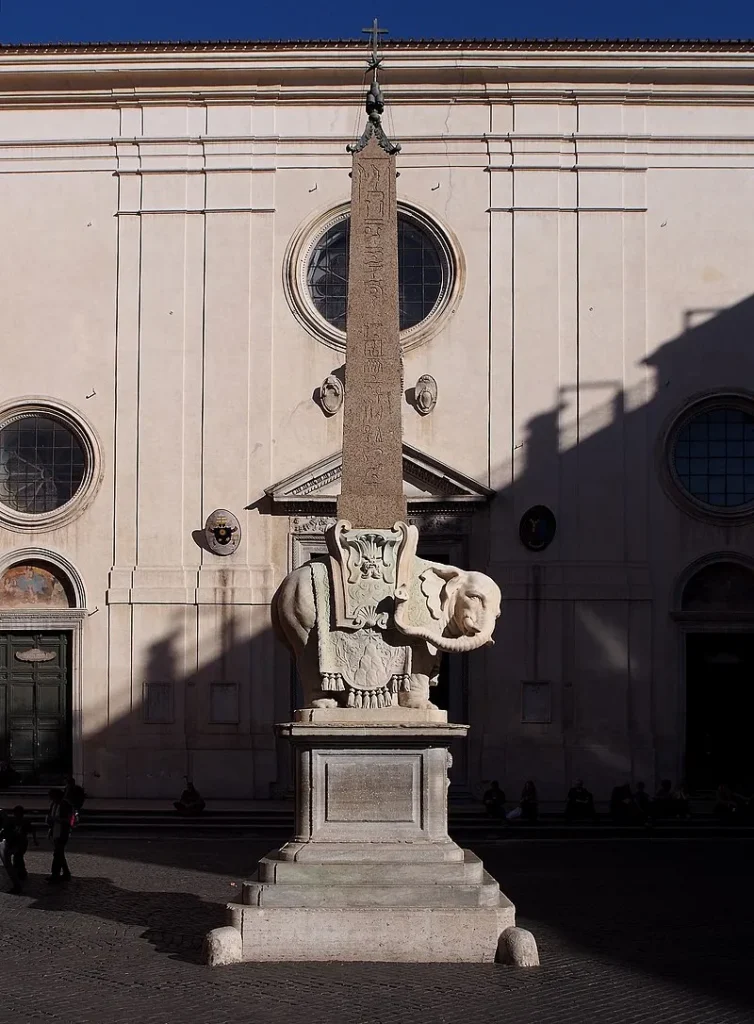
The Elephant and Obelisk Sculpture
In front of the Church of Santa Maria sopra Minerva stands one of Rome’s most curious monuments, the Pulcino della Minerva. This statue, created by the renowned Baroque sculptor Gian Lorenzo Bernini and executed by his pupil Ercole Ferrata in 1667, features a small elephant carrying an Egyptian obelisk on its back. The obelisk is the shortest of the eleven Egyptian obelisks in Rome and was originally brought to Rome from the city of Sais in Egypt by Emperor Diocletian during his reign (284–305 AD). It was placed at the Temple of Isis, which once stood nearby.
The elephant itself was designed as a supporting base for the obelisk. The inscription chosen by Pope Alexander VII, who commissioned the sculpture, reads: “…a strong mind is needed to support a solid knowledge.” The design is said to have been inspired by a passage from Hypnerotomachia Poliphili (“Poliphilo’s Dream of the Strife of Love”), a 15th-century novel, in which the protagonist encounters a stone elephant carrying an obelisk. The woodcut illustration from the book closely mirrors Bernini’s design.
The monument’s unusual appearance led to it being nicknamed “Porcino” (meaning “Piggy”) due to the perceived bulkiness of the structure. Over time, the name evolved into “Pulcino” (Italian for “chick”), possibly referring to the relatively short height of the obelisk or to the charity work of the Dominican order in assisting young women with dowries. A painting from the period depicted these women, symbolized as tiny figures, in a procession in the church courtyard.
Cultural References
Literary and Artistic Inspirations
The Pulcino della Minerva and the Church of Santa Maria sopra Minerva feature in various cultural works, most notably in the novel The Tomb of Alexander by Sean Hemingway. In the novel, it is claimed that a secret passageway beneath the church leads to a chamber beneath the elephant monument, where the body of Alexander the Great is said to be buried, placed there by Pope Alexander VII in the 17th century. This theory, however, is purely fictional and lacks any historical evidence.
The image of the elephant carrying an obelisk has also influenced visual art, most famously in Salvador Dalí’s painting Les Elephants (1948). In this work, Dalí depicts two elephants with spindly legs seemingly supporting obelisks. The motif is also present in other works by Dalí, such as Dream Caused by the Flight of a Bee Around a Pomegranate a Second Before Awakening (1944) and The Temptation of Saint Anthony (1946), further cementing the cultural impact of this striking image.
Feast Day
Feast Day: 15 August
The feast day of the Basilica of Saint Mary of Minerva (Santa Maria sopra Minerva) is celebrated on August 15, which is the Feast of the Assumption of the Blessed Virgin Mary. This is a significant feast day in the Catholic Church, commemorating the belief that the Virgin Mary was assumed body and soul into Heaven. Since the basilica is dedicated to the Virgin Mary, it is particularly celebrated on this date.
Church Mass Timing
Monday : 7:15 AM , 6:00 PM
Tuesday : 7:15 AM , 6:00 PM
Wednesday : 7:15 AM , 6:00 PM
Thursday : 7:15 AM , 6:00 PM
Friday : 7:15 AM , 6:00 PM
Sunday : 11:00 AM , 6:00 PM
Church Opening Time:
Monday : 10:30 am–1:00 pm, 2:00 pm –7:30 pm
Tuesday : 10:30 am–1:00 pm, 2:00 pm –7:30 pm
Wednesday : 10:30 am–1:00 pm, 2:00 pm –7:30 pm
Thursday : 10:30 am–1:00 pm, 2:00 pm –7:30 pm
Friday : 10:30 am–1:00 pm, 2:00 pm –7:30 pm
Saturday : 10:30 am–1:00 pm, 2:00 pm –7:30 pm
Sunday : 10:30 am–1:00 pm, 2:00 pm –7:30 pm
Contact Info
Address :
Piazza della Minerva, 42, 00186 Roma RM, Italy.
Phone : +39 333 746 8785
Accommodations
Connectivities
Airway
Leonardo da Vinci International Airport (FCO), to Basilica of Saint Mary of Minerva, Rome, Italy distance between 36 min (28.5 km) via A91.
Railway
Stazione Roma Termini Via Giovanni Giolitti, Rome, to Basilica of Saint Mary of Minerva, Rome, Italy distance between 18 min (3.3 km) via Via Cavour.

